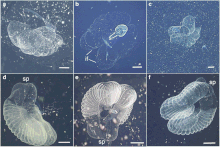| Appendicularia | |
|---|---|

| |
| Appendicularia sp., a genus of fritillariid larvacean | |

| |
| Houses of Bathochordaeus charon (top) and B. stygius (bottom), two species of giant larvacean | |
| Scientific classification | |
| Domain: | Eukaryota |
| Kingdom: | Animalia |
| Phylum: | Chordata |
| Subphylum: | Tunicata |
| Class: | Appendicularia Fol, 1872[1] |
| Order: | Copelata Haeckel, 1866 |
| Families and genera | |
| |
| Synonyms | |
| |
Larvaceans or appendicularians, class Appendicularia, are solitary, free-swimming tunicates found throughout the world's oceans. While larvaceans are filter feeders like most other tunicates, they keep their tadpole-like shape as adults, with the notochord running through the tail. They can be found in the pelagic zone, specifically in the photic zone, or sometimes deeper. They are transparent planktonic animals, usually ranging from 2 mm (0.079 in) to 8 mm (0.31 in) in body length including the tail, although giant larvaceans can reach up to 10 cm (3.9 in) in length.[4]
Larvaceans are known for the large houses they build around their bodies to assist in filter-feeding. Secreted from mucus and cellulose, these structures often comprise several layers of filters and can reach up to ten times their body length. In some genera like Oikopleura, houses are built and discarded every few hours, with sinking houses playing a key role in the oceanic carbon cycle.
- ^ "Appendicularia" (PDF). Australian Government – Department of Climate Change, Energy, the Environment and Water. Archived (PDF) from the original on 10 April 2023. Retrieved 10 April 2023.
- ^ Archives de zoologie expérimentale et générale. Vol. 3. 1874. Archived from the original on 10 April 2023. Retrieved 10 April 2023.
- ^ Fenaux, R.; Bone, Q.; Deibel, D. (1998). "Appendicularian distribution and zoogeography". In Bone, Q. (ed.). The biology of pelagic tunicates. Oxford University Press. pp. 251–264.
- ^ Cite error: The named reference
carbonwas invoked but never defined (see the help page).